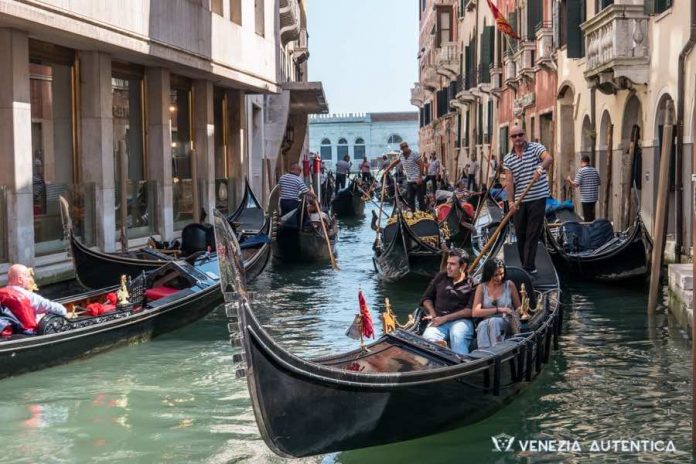Discover the history of the famous black boat used for centuries in the lagoon which has become the symbol of the city itself. It’s hard to imagine Venice Italy without its quintessentially venetian boat, the Gondola! Even today, the craft of constructing the venetian gondola is carried out by master carpenters in the squeri, the traditional rowing boat shipyard in Venice.
Discover the secrets behind taking a Venetian gondola ride in the Grand Canal. Gondolas are flat bottomed boats that are driven with a single oar, requiring a skilled rower. The most famous of these rowers are the gondoliers, but they are not the only ones! If you watch out you might also see two and four-oared gondolas sailing on the Grand Canal.
What is a Gondola ?
The gondola is the most typical of Venetian boats. Dark in color and with a long slender shape, it is 10.85 metres long and 1.44 metres wide. It has a flat bottom to allow navigation even in very shallow waters, such as those of the lagoon.
One of its unusual features is that its bottom is asymmetric in order to balance the weight of the gondolier on the opposite side! Eight different types of wood are used in its construction. Oak, larch, fir, linden, elm, walnut, mahogany, and some cherrywood.
Nowadays, the gondola is still produced in Venice, in the “squero” or craftsman’s workshop which always opens towards the canals of venice. The most famous is the squero of San Trovaso, which is in the style of a “mountain hut” underlining the fact that the artisans have their origins in the mountainous areas of Belluno.
Building a gondola involves at least 12 months of work by different artisans: the “squeraiol”, the famous master carpenters in Venetian language, the “Battiloro”, the goldsmith who is responsible for the gold decorations and the blacksmith who make the gondola iron prow-head by hand!
Why is a Venetian Gondola black?
Have you ever wondered why the gondola was always built in black?
Well, as a matter of aesthetics, black has always been considered synonymous with elegance, and nobles loved being fashionable! But before elegance entered the lagoon, a private gondola would be decorated in over the top bright colours and patterns. A celebration of kitsch and ostentation!
So in 1609 a decree was issued, which obliged the boat typical of the Venice lagoon, to be painted only in black! This kept things elegant and practical, given that the colour of the pitch used to waterproof it is also black.
The gondola gold decorations – the Battiloro’s art
ccording to how luxurious the gondola is, it is then decorated with gold. You may be wondering if this is real gold or not, and the answer is: yes, it certainly is real gold! The Battiloro are the artisans who beat gold with a hammer. thinning it down to very thin leaves which are then used to decorate the gondola. The more luxurious the gondola is, the greater amount of golden leaf will be used to decorate it. The most ornated gondolas are the ones used for ceremonies and weddings.













